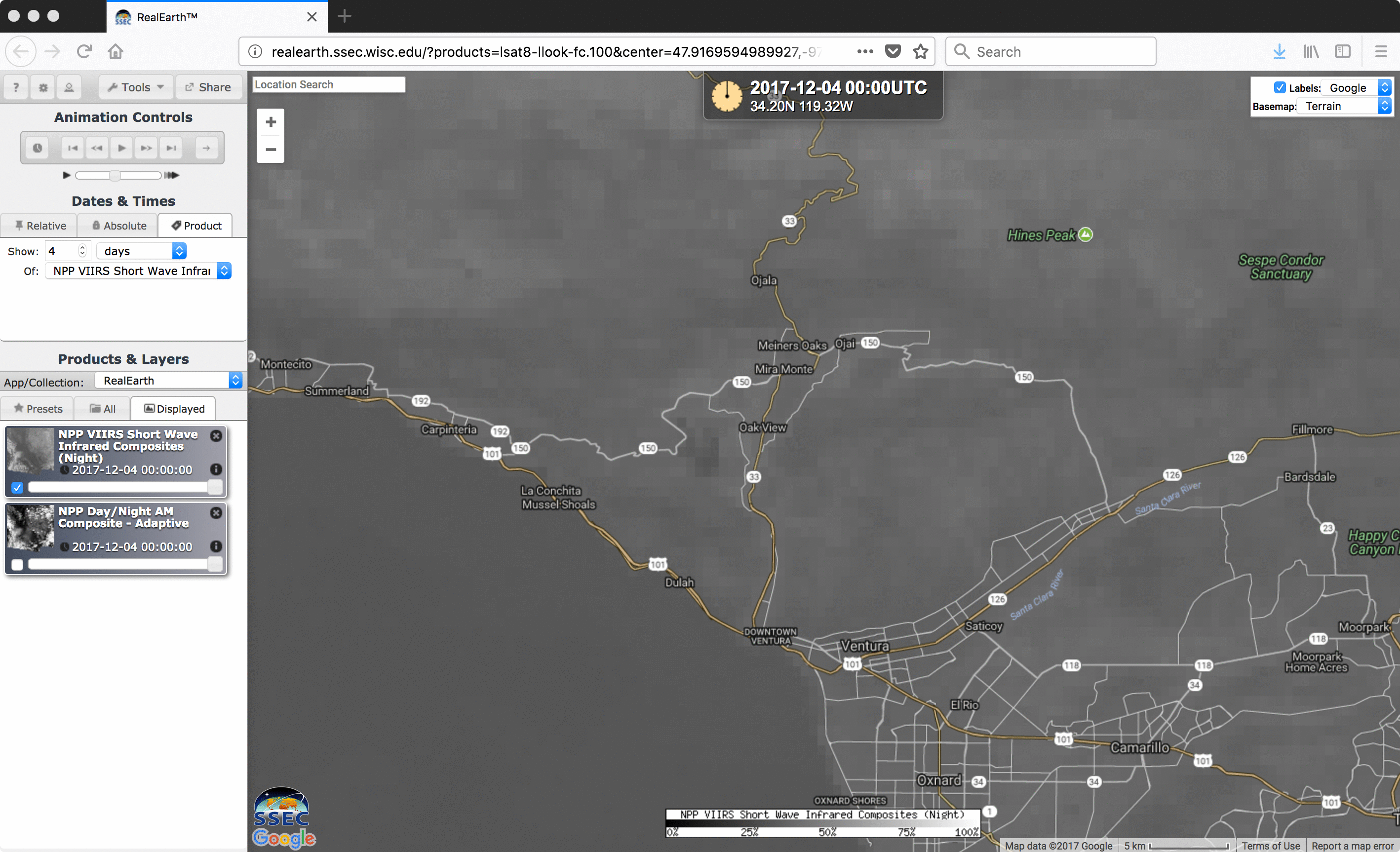Wildfires in southern California
GOES-15 (GOES-West) Shortwave Infrared (3.9 µm) images (above; also available as an animated GIF) showed the rapid development of wildfires driven by strong Santa Ana winds in Southern California on 05 December 2017. The fire thermal anomalies or “hot spots” are highlighted by the dark black to yellow to red pixels — the initial signature was evident on the 0230 UTC image (6:30 PM local time on 04 December), however the GOES-15 satellite was actually scanning that particular area at 0234 UTC or 6:34 PM local time. The Thomas Fire (the largest of the fires) advanced very quickly toward the southwest, nearly reaching the coast.Nighttime image toggles between Suomi NPP VIIRS Shortwave Infrared (3.74 µm) and Day/Night Band (0.7 µm) data at 0904 UTC and 1044 UTC (below) revealed the large fire hot spots, along with the extensive smoke plume that was drifting over the adjacent nearshore waters of the Pacific Ocean. With ample illumination from the Moon (which was in the Waning Gibbous phase, at 95% of Full), the “visible image at night” capability of the VIIRS Day/Night Band — which will also be available from the recently-launched JPSS-1/NOAA-20 satellite — was clearly demonstrated.
![Suomi NPP VIIRS Shortwave Infrared (3.74 µm) and Day/Night Band (0.7 µm) images, with plots of surface reports [click to enlarge]](https://cimss.ssec.wisc.edu/satellite-blog/wp-content/uploads/sites/5/2017/12/171205_0904utc_suomi_npp_viirs_ShortwaveInfrared_DayNightBand_SoCal_fires_anim.gif)
Suomi NPP VIIRS Shortwave Infrared (3.74 µm) and Day/Night Band (0.7 µm) images, with plots of surface reports [click to enlarge]
![Suomi NPP VIIRS Shortwave Infrared (3.74 µm) and Day/Night Band (0.7 µm) images, with plots of surface reports [click to enlarge]](https://cimss.ssec.wisc.edu/satellite-blog/wp-content/uploads/sites/5/2017/12/171205_1044utc_suomi_npp_viirs_ShortwaveInfrared_DayNightBand_SoCal_fires_anim.gif)
Suomi NPP VIIRS Shortwave Infrared (3.74 µm) and Day/Night Band (0.7 µm) images, with plots of surface reports [click to enlarge]
GOES-15 Visible (0.63 µm, top) and Shortwave Infrared (3.9 µm, bottom) images [click to play MP4 animation]
===== 06 December Update =====
![Suomi NPP VIIRS Day/Night Band (0.7 µm) and Shortwave Infrared (3.75 µm and 4.05 µm) images [click to enlarge]](https://cimss.ssec.wisc.edu/satellite-blog/wp-content/uploads/sites/5/2017/12/171206_1027utc_viirs_DayNightBand_ShortwaveInfrared_NearInfrared_SoCal_fires_anim.gif)
Suomi NPP VIIRS Day/Night Band (0.7 µm) and Shortwave Infrared (3.75 µm and 4.05 µm) images [click to enlarge]
GOES-15 Shortwave Infrared (3.9 µm) images (below) displayed the thermal signatures exhibited by the fires. Note the appearance of a new fire — the Skirball Fire — first appearing on the 1300 UTC (5:00 AM local time) image, just north of Santa Monica (KSMO). Although the Santa Ana winds were not quite as strong as the previous day, some impressive wind gusts were still reported.
A toggle between 250-meter resolution Terra (1911 UTC) & Aqua (2047 UTC) MODIS true-color images from MODIS Today (below) showed significant pyrocumulus development from a flare-up along the northeast perimeter of the Thomas Fire. The cloud plume only exhibited a minimum infrared brightness temperature of +5.5º C on the corresponding Aqua MODIS Infrared Window image, far above the -40ºC threshold assigned to pyroCumulonimbus clouds.===== 07 December Update =====
RealEarth imagery of the Day Night Band over 5 days (one image each night from 3 through 7 December), above, shows the evolution of the fire complex (Imagery courtesy Russ Dengel, SSEC). Similarly, a closer view of daily composites of VIIRS Shortwave Infrared (3.74 µm) imagery (below) revealed the growth and spread of the Thomas Fire from 04-07 December.
In a toggle between Terra MODIS true-color and false-color RGB images (below), the large burn scar of the Thomas Fire (shades of red to brown) was very apparent on the false-color image.

![Suomi NPP VIIRS Day/Night Band (0.7 µm) images [click to enlarge]](https://cimss.ssec.wisc.edu/satellite-blog/wp-content/uploads/sites/5/2017/12/171205_suomi_npp_viirs_DayNightBand_anim.gif)
![Suomi NPP VIIRS 4.05 µm and 3.75 µm Shortwave Infrared images [click to enlarge]](https://cimss.ssec.wisc.edu/satellite-blog/wp-content/uploads/sites/5/2017/12/171205_0907utc_viirs_shortwave_infrared_anim.gif)
![Aqua MODIS true-color RGB image [click to enlarge]](https://cimss.ssec.wisc.edu/satellite-blog/wp-content/uploads/sites/5/2017/12/171205_aqua_modis_truecolor_SoCal_fires.jpg)
![Comparison of Terra (1911 UTC) & Aqua (2047 UTC) MODIS true-color RGB images [click to enlarge]](https://cimss.ssec.wisc.edu/satellite-blog/wp-content/uploads/sites/5/2017/12/171206_terra_aqua_modis_truecolor_SoCal_fires_anim.gif)


![Terra MODIS true-color and false-color images [click to enlarge]](https://cimss.ssec.wisc.edu/satellite-blog/wp-content/uploads/sites/5/2017/12/171207_1816utc_terra_modis_truecolor_falsecolor_SoCal_fires_anim.gif)